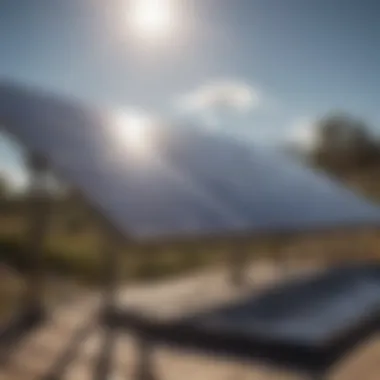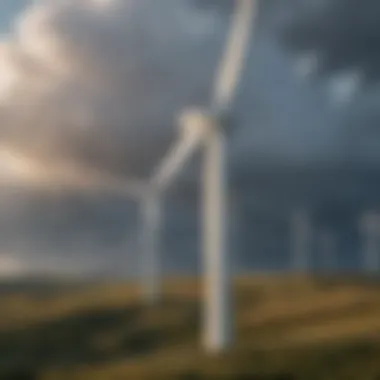Low Carbon Power Sources: A Comprehensive Overview


Intro
In the contemporary dialogue surrounding energy production, the shift towards low carbon power sources has become more than just a trend; it’s a necessity. As climate change looms, the reliance on fossil fuels becomes increasingly scrutinized. Hence, this article aims to systematically explore the intricacies of various renewable energy sources such as solar, wind, and hydro, shedding light on their roles in curbing greenhouse gas emissions.
What this piece offers is not simply a surfacing of facts, but a layered analysis that dives into the technology, policies, and scientific endeavors that elucidate how we approach our energy demands sustainably. With a focus on real-world implications, it’s essential to understand the avenues these low carbon solutions present and the broader impact they may hold on our planet and society.
"With the stakes as high as they are, exploring low carbon energy sources is vital in crafting an energy future that is resilient and environmentally sound."
As we venture further, the narrative will dissect the methodologies underpinning current research and innovations, juxtaposed against the roadblocks faced within the sector.
Understanding Low Carbon Power Sources
The concept of low carbon power sources is not just a passing trend or a luxury for a greener future; it serves as a vital pivot for the world's energy strategy. Understanding low carbon power sources is essential in the backdrop of climate change and depleting fossil fuels. These energy sources reduce greenhouse gas emissions, thereby playing a crucial role in combating global warming.
As we delve into this topic, several elements come into play. Firstly, there are the technological advancements that make harnessing these energy forms not only feasible but also more efficient and accessible. With improvements in solar panels and wind turbines, countries can increasingly depend on energy that doesn’t rattle the climate.
Moreover, a stronger grip on the environmental impact of our energy choices allows individuals and policymakers to make informed decisions. Recognizing the importance of sustainability, companies target low carbon solutions, pushing for innovative methods and applications.
In addition, today’s energy landscape is characterized by a mix of interdependencies between countries and the need for collaboration. Low carbon power sources can lead to energy independence, allowing nations to break free from reliance on fossil fuels that often come with political and economic repercussions. All these points underscore why understanding low carbon power sources is foundational in our pursuit toward a sustainable energy future.
Definition and Importance
Low carbon power sources can be defined as forms of energy that are generated with minimal or no greenhouse gas emissions during their lifecycle. This includes renewable energies like solar, wind, hydroelectric, and geothermal, as well as newer technologies that employ carbon capture and storage methods. The importance of these sources lies in their ability to replace traditional energy systems that are heavily reliant on coal, oil, and natural gas, which contribute significantly to carbon footprints.
In essence, low carbon power sources offer a pathway to a cleaner environment, improved public health, and potentially greater energy efficiency as technology continues to evolve.
Current Energy Landscape
The current energy landscape reflects a high-stakes balance between demand, supply, and environmental responsibility. A significant overlap of politics, economics, and technology shapes this sector. As fossil fuel resources wane, there is increased emphasis on diversifying energy portfolios with low carbon alternatives. Countries around the globe are ramping up investments in solar parks and wind farms, aiming to harness these renewable capacities effectively.
The International Energy Agency reported that renewable energy sources accounted for nearly 30% of global electricity generation in recent years, reflecting a marked shift toward these sustainable options.
However, the transition isn’t without its hurdles. Technological barriers and policy frameworks often lag behind the pace of innovation in renewable technologies. Public awareness also plays a pivotal role; the more informed the populace is on the benefits and necessity of low carbon sources, the more support there will be for initiatives and projects geared towards clean energy.
Ultimately, by understanding the definitions and the current state of energy sources, we arm ourselves with the knowledge to advocate for more sustainable practices and polices, ensuring that low carbon power sources are not only recognized but prioritized.
Types of Low Carbon Power Sources
The landscape of energy production is shifting towards low carbon power sources due to increasing environmental concerns and the urgent need to mitigate climate change. This shift is not just advantageous but essential. Energizing economies while minimizing carbon emissions creates a balanced approach towards sustainable development. Addressing both local and global energy needs through diverse low carbon sources, allows for a multi-faceted strategy, enhancing resilience and energy security.
Solar Energy
Photovoltaic Technology
Photovoltaic (PV) technology stands out as a leading solar energy solution, converting sunlight directly into electricity. This process is clean and incredibly effective, which marks its importance in the low carbon energy movement. The standout feature of PV panels is their modularity; they can be installed on rooftops or large-scale solar farms, making them remarkably versatile. However, the critical point of consideration is the production of the panels themselves, which, while improving, still involves certain environmental costs.
CSP Systems
Concentrated Solar Power (CSP) systems utilize mirrors or lenses to focus sunlight onto a small area, usually a receiver. This technology differs from PV in that it generates electricity through heat rather than direct conversion. CSP systems are a beneficial choice, particularly in regions with abundant sunlight. However, their deployment can be limited by geographical constraints, and they demand significant upfront investment and land use.
Applications and Benefits
Solar energy has a diversified range of applications. From powering homes to large enterprises, its utility is manifold. The primary benefit lies in its potential for energy independence and the reduction of utility costs over time. However, a unique downside includes dependence on sunlight availability, which can challenge energy production during cloudy days or nighttime hours.
Wind Energy
Onshore vs. Offshore Wind Farms
Onshore and offshore wind farms serve as two distinct frontiers in capturing wind's kinetic energy. Onshore farms are easier to install and maintain, but they often face limitations in capacity and can disrupt local ecosystems. Offshore farms, meanwhile, can harness stronger and more consistent winds, but require more substantial investment and innovative engineering solutions. Balancing these factors is key to optimizing the benefits of wind energy.
Wind Turbine Technology
Modern wind turbines come with significant advancements in design and efficiency. Today's turbines have longer blades and higher towers, which enable them to capture more wind energy. This increasing efficiency makes wind energy a compelling option for many countries. However, the presence of turbines can also present challenges such as noise and visual impact on landscapes.


Environmental Impact
Wind energy has a notably reduced carbon footprint compared to fossil fuel-based sources. However, concerns arise regarding potential effects on wildlife, particularly birds and bats. To mitigate these impacts, ongoing research and innovative turbine designs aim to minimize risks to local animal populations. Thus, while wind energy is critical for a low carbon future, attention to ecological considerations remains paramount.
Hydropower
Dams and Run-of-River Systems
Dams and run-of-river systems are essential components of hydropower production. Dams can create large water reservoirs, providing a stable supply of energy. However, they can also disrupt local ecosystems significantly. Run-of-river systems, in contrast, make use of existing water flows without large reservoirs, which can be less intrusive but may have limitations in energy generation methods during dry spells.
Small-Scale Hydropower
Small-scale hydropower generates energy using smaller water features and has gained traction in local energy markets. This solution is advantageous as it often has a lower environmental footprint and can be easier to deploy in remote areas. However, infrastructure challenges and regulatory compliance can pose difficulties in development.
Ecological Considerations
When discussing hydropower, it is crucial to consider ecological impacts. The construction of dams, for instance, can impede fish migration and alter aquatic ecosystems. Sustainable hydropower focuses on balancing energy generation with ecological health, which necessitates careful planning and innovative design measures to protect biodiversity.
Geothermal Energy
Types of Geothermal Plants
Geothermal plants fall into several categories, including dry steam, flash steam, and binary cycle plants, each utilizing different methods to harness heat from the Earth. Their distinct characteristics allow for diverse applications, making geothermal a valuable low carbon power source. Each type presents unique challenges, such as location limitations and varying installation costs.
Potential and Limitations
Geothermal energy offers tremendous potential in areas with significant geothermal activity. However, its limitations are often geographical—only specific regions can effectively tap into geothermal resources. Additionally, exploration and drilling can incur high upfront costs, making it a challenging investment.
Recent Developments
The advancements in geothermal energy technology have made it more viable and efficient. Innovations in drilling techniques and enhanced resource assessment have opened new avenues for harnessing geothermal heat. These developments make it an appealing option, albeit not without technical and regulatory hurdles that still need to be addressed.
Biomass Energy
Types of Biomass
Biomass energy is derived from organic materials, which can range from wood to waste products. This diversity offers flexibility in energy production. However, not all biomass sources are created equal. Some may lead to deforestation or land-use change, raising sustainability concerns.
Sustainability Issues
While biomass can be a renewable energy source, sustainability issues arise regarding land use and carbon neutrality. The life-cycle emissions of biomass energy systems are crucial for evaluation. It becomes vital to ensure that biomass sources do not compromise food security or lead to significant land alterations.
Conversion Processes
The conversion processes for biomass can be complex, comprising mechanical, thermal, and biological methods. Each method presents unique features that influence efficiency and emissions. For example, gasification can produce cleaner fuels from diverse biomass types, but requires advanced technology and may entail higher costs.
Advantages of Low Carbon Power Sources
The importance of low carbon power sources lies in their transformative potential for today’s energy ecosystem. These sources provide multiple benefits, from mitigating climate change to fostering economic growth and improving national security. The pivot to low carbon fuels is not merely a trend; it's a vital pivot towards sustainability. In essence, they hold the promise of cleaner energy with fewer environmental hazards. Here are some specific advantages that these power sources bring to the table:
Reduction of Greenhouse Gas Emissions
One of the standout advantages of low carbon power sources is their ability to significantly cut greenhouse gas emissions. Traditional energy generation relies heavily on fossil fuels like coal and natural gas, which release large amounts of carbon dioxide. In stark contrast, renewable sources like wind, solar, and biomass emit little to no greenhouse gases during their operation. This transition to renewables can lead to a marked decrease in air pollution and consequent health benefits.
"Adopting low carbon power sources is not just about energy; it’s about protecting our planet for future generations."
Imagine a community that transitions from coal to solar power: increased air quality can translate to lower healthcare costs and improved quality of life for residents. Furthermore, with nations committing to international agreements like the Paris Agreement, the implementation of low carbon sources becomes essential in meeting emission reduction targets.
Energy Security and Independence
Energy security is a hot topic in national discussions, and low carbon power sources play a crucial role in this. When countries invest in local and renewable energy sources, they decrease their reliance on imported fossil fuels. This independence not only enhances energy security but also shields nations from the economic vulnerabilities tied to fluctuating fossil fuel prices.
For instance, Germany's Energiewende, or "energy transition," emphasizes renewable energy. As they ramp up wind and solar production, they reduce dependencies on external sources, thus harnessing both economic and strategic advantages. Improved energy security fosters a stable economic environment and cultivates resilience against geopolitical tensions.


Economic Benefits
The shift towards low carbon energy sources comes with considerable economic benefits.
Job Creation
One notable aspect of job creation within the low carbon sector is its rapid pace compared to traditional energy jobs. According to reports by the International Renewable Energy Agency, renewable energy sectors create more jobs per unit of electricity generated than fossil fuel sectors. The growth of the solar and wind industries has spawned countless employment opportunities—from engineering roles to installation jobs for technicians.
This job creation is a beneficial factor, especially in regions facing economic challenges. As communities embrace these new technologies, they not only cut emissions but also invest in local workforces. The unique feature of job creation in low carbon sectors is that they often offer skills training and development, providing workers with tools for future jobs. Nevertheless, it is crucial to acknowledge that some traditional energy jobs may become obsolete, necessitating smart policies to manage such transitions.
Investment Opportunities
The investment landscape is also evolving, making low carbon sources a focal point for potential investors. These sources present lucrative avenues for investment, spurred by a growing public interest in environmentally friendly initiatives. Financial institutions are increasingly backing renewable energy projects, creating a ripple effect in local economies.
The unique feature of these investment opportunities is their longevity. Renewable energy projects commonly have long-term financial benefits, such as stable energy prices and lower maintenance costs. However, the initial setup and regulatory processes can be daunting. Investors require clear frameworks and policies to ensure their investments are economically viable.
Overall, the advantages of low carbon power sources extend far beyond environmental perks. They offer a holistic approach, promoting economic stability, enhanced security, and, crucially, a cleaner planet.
Challenges in Implementing Low Carbon Power Sources
The transition to low carbon power sources is not merely a technical feat; it’s a complex web of challenges that need careful consideration. As society moves toward more sustainable energy practices, it is crucial to address the hurdles that stand in the way of progress. By understanding these challenges, one can better appreciate the significance of innovative solutions and collaborative efforts necessary for a successful energy transition.
Technological Barriers
Technological barriers present a formidable obstacle in the drive to implement low carbon power sources.
Many renewable technologies are still maturing, grappling with efficiency issues and high initial costs. For example, photovoltaic solar panels have experienced vast advancements, yet they can still be cost-prohibitive for some regions. Moreover, energy storage technologies, such as lithium-ion batteries, face challenges with scalability and sustainability. Besides, there is the matter of interconnectivity among various energy systems. Upgrading existing grid infrastructure requires significant investments and time, which often leads to political pushback.
Developments in energy efficiency are crucial. Countries need to invest in R&D for innovative technologies that enhance energy conversion and storage efficiencies. This can significantly lower costs and increase reliability while also contributing to energy independence.
Policy and Regulatory Issues
Efforts to enhance low carbon power sources are often stymied by policy and regulatory complications.
Regulatory frameworks are not always conducive to fostering renewable energy projects. Often, there are outdated regulations, which might promote fossil fuel industries rather than renewables. Unclear or shifting policies create uncertainty, leaving investors wary. This vacuum of clarity can deter significant investment in new low carbon technologies.
Incentives and subsidies play a critical role in making low carbon technologies more attractive. For instance, feed-in tariffs and tax credits for renewable energy sources can significantly level the playing field. However, these policies can vary greatly across regions. A consistent and supportive framework can effectively encourage greater stakeholder participation and financing, paving the way for sustainable energy initiatives.
Public Acceptance and Awareness
Public opinion can make or break renewable energy projects. While environmental benefits are widely acknowledged, acceptance of energy projects is another story.
Many people are still skeptical about the feasibility of low carbon technologies or involve in NIMBY (Not In My Backyard) attitudes. Communities may resist projects like wind turbines or solar farms due to perceived negative impacts on local aesthetics or wildlife. Increasing awareness through education can bridge this gap. Individuals must understand the benefits of low carbon technologies, both locally and globally, as well as the long-term implications of climate change.
Local engagement initiatives, where communities can weigh in on projects, can foster a sense of ownership and pride. Effective outreach campaigns that focus on community benefits, job creation, and environmental impacts serve to build trust and support for low carbon initiatives.
Understanding these challenges will help policymakers, industry players, and communities come together to foster an environment in which low carbon power sources can genuinely thrive.
The challenges in implementing low carbon power sources are numerous and complex, but they are not insurmountable. Recognizing the technological barriers, refining policy frameworks, and fostering public acceptance are key elements in successfully moving toward a more sustainable energy future.
Future Trends in Low Carbon Energy
In the ever-evolving scenario of energy production, future trends in low carbon energy hold considerable importance. They shape the pathways through which societies can effectively transition from reliance on fossil fuels to more sustainable alternatives. Understanding what lies ahead in this domain can illuminate opportunities and challenges for stakeholders ranging from policymakers to private enterprises.
Innovative Technologies
Energy Storage Solutions
A crucial aspect of energy storage solutions is their ability to balance supply and demand in renewable energy systems. As we rely increasingly on sources like solar and wind, which are intermittent by nature, the capacity to store energy for later use becomes vital.
One key characteristic of these solutions is their flexibility. They can vary from large-scale battery systems, like those developed by Tesla, to smaller setups for residential use, such as the LG Chem RESU.
A particularly unique feature of energy storage systems is their rapid response time. This capability allows energy grids to distribute power where it’s needed most instantly. However, challenges do exist, such as the cost of materials and environmental impact of battery production. Navigating these issues will be essential for their widespread adoption and success.


Smart Grids
The integration of smart grids into our energy systems is another exciting development. Unlike traditional power grids, smart grids use advanced technology to monitor, manage, and respond to energy consumption patterns in real time. Their key characteristic is the connectivity between energy producers and consumers, providing more transparency and control over energy use.
What sets smart grids apart is their ability to incorporate various energy sources, creating a more resilient energy network. Consumers can adjust usage based on real-time pricing and supply availability, which can lead to both economic savings and reduced environmental impact.
Still, there are some downsides to this concept. Cybersecurity remains a significant concern, as increased connectivity is also an invitation for potential threats. Adequate investment in secure technologies is necessary to protect these systems.
Global Policy Developments
Global policy shifts profoundly influence the trajectory of low carbon energy sources. Countries are increasingly committing to international agreements aimed at reducing greenhouse gas emissions. The Paris Agreement sets goals for limiting global warming, incentivizing nations to transition to cleaner energy, while fostering cooperation on technology sharing. Local regulations, subsidies, and incentives aimed at promoting renewables will also determine how swiftly these policies can be implemented.
Moreover, various international bodies focus on creating frameworks that balance environmental goals with social and economic factors. Such frameworks can encourage investments in low-carbon technologies while ensuring job satisfaction and economic growth for local communities.
Interdisciplinary Collaborations
Interdisciplinary collaborations emerge as a cornerstone of effective implementation of low-carbon energy strategies. The complexity of the energy landscape means that solutions often require expertise from various fields. Engineers, environmental scientists, economists, and urban planners all play crucial roles in developing comprehensive strategies for transition.
For instance, partnerships between universities and energy firms can foster innovation in renewable technologies and energy efficiency practices. These collaborations also enhance research funding and provide practical applications for theoretical work.
In short, these collective efforts can lead to a comprehensive understanding of energy challenges, allowing for tailored solutions that address local and global needs.
Future trends in low carbon energy are not just about technology; they involve integrated efforts across disciplines and stakeholders to create resilient systems.
Case Studies of Successful Implementation
Exploring case studies in the implementation of low carbon power sources offers invaluable insights into their potential and challenges. They serve as real-world examples that reflect the practical applications of renewable energy technologies, helping to illuminate pathways that can be taken by other nations or organizations. By investigating the successes and hurdles faced, we gain a more comprehensive understanding of how to enhance energy systems sustainably.
Countries Leading in Renewable Energy
Several countries have set exemplary standards in adopting renewable energy solutions, gaining recognition for their leadership in the global transition towards low carbon power. Here are a few notable examples:
- Denmark: Known for its pioneering wind energy initiatives, Denmark produces about 47% of its electricity from wind turbines. The country has made significant progress in integrating wind into its grid while managing challenges related to energy storage and grid stability. Their commitment to renewable energy is evident in ambitious national policies aimed at achieving 100% renewable energy by 2050.
- Germany: As a frontrunner in solar power, Germany's "Energiewende" (energy transition) policy has successfully scaled up solar installations across the nation. The vigorous promotion of solar photovoltaic systems showcases how strong regulatory frameworks can support the expansion and accessibility of renewables.
- Costa Rica: This Central American nation proudly claims that over 99% of its electricity comes from renewable sources. Hydropower plays a significant role, with a range of well-managed projects ensuring sustainable production and minimal ecological disruption. This achievement serves as an inspiring example for others aiming to increase renewable energy contributions.
"Costa Rica demonstrates that it is possible to achieve significant milestones toward renewable energy while maintaining a focus on sustainability and ecological preservation."
- China: As the world's largest producer of solar panels and a leader in energy investment, China's rapid adoption of renewable energy technologies cannot be overlooked. While grappling with pollution challenges, the country has shown determination to shift toward cleaner power sources, with ambitious targets and large-scale solar and wind energy installations.
Notable Projects and Initiatives
Several distinct projects and initiatives around the globe further illustrate the potential of low carbon power sources:
- The Hornsea Project in the UK: This massive offshore wind farm is set to become the world's largest, with a capacity of over 2.6 GW, enough to power approximately 1.3 million homes. Its scale demonstrates the viability of offshore wind energy as a fundamental component of transitioning to a low carbon future.
- Gemini Wind Park in the Netherlands: Another large offshore project, Gemini boasts a capacity of 600 MW and showcases the successful integration of local communities in its planning and implementation processes. This initiative has strengthened public support for the sustainable energy movement.
- The Ivanpah Solar Power Facility in California: One of the largest solar thermal power plants in the world, Ivanpah combines technology innovations with practical applications. Although it has faced its share of environmental criticisms, advancements made at Ivanpah push the boundaries of solar energy applications.
- The LCOE Initiative: This initiative aims to lower the Levelized Cost of Electricity for renewable sources through collaborative strategies. By pooling resources from various sectors and stakeholders, it showcases how innovative funding and support mechanisms can enhance the feasibility of projects.
In summary, the review of these countries and projects weaves together a narrative of resilience, ingenuity, and determination. Each case highlights unique methodologies and strategies, underlining that while challenges remain, the pathways toward low carbon power are more visible, informed by the successes and warnings derived from prior implementations.
The End
In wrapping up the discussion surrounding low carbon power sources, it’s clear that these energy alternatives are not just buzzwords or passing fads. Instead, they represent a fundamental shift in how we think about and utilize energy. The significance of low carbon power sources cannot be understated, especially in a world grappling with climate change and environmental degradation. Their potential to mitigate greenhouse gas emissions and foster energy independence makes them invaluable.
Summary of Key Points
To synthesize the information presented, several key points emerge:
- Low carbon power sources, which include solar, wind, hydropower, and biomass, are essential for reducing our carbon footprint.
- The advantages of adopting these technologies are not confined to the environmental sphere. They also encompass economic benefits such as job creation and investment potential.
- Despite their advantages, the implementation of these technologies faces challenges. Technological barriers and regulatory hurdles must be navigated to realize their full potential.
In light of these points, every stakeholder—from policymakers to educators—must work collaboratively to realize the potential of low carbon power sources.
The Path Forward
Looking ahead, the path forward is multifaceted.
- Innovation is vital: Continued investment in research and development is necessary to advance technologies like energy storage and smart grids. Enhancing the efficiency and reliability of low carbon technologies can make a significant difference in their adoption.
- Global collaboration is essential: International partnerships can lead to shared knowledge, economic investments, and joint ventures that amplify renewable energy explorations. An example can be seen in China and Germany's collaboration in solar technologies.
- Education and advocacy: Awareness campaigns and educational initiatives are crucial in fostering a well-informed public, which can advocate for and adopt these technologies in their daily lives.
"We do not inherit the Earth from our ancestors; we borrow it from our children."
- Native American Proverb
Given these prospects, the commitment to low carbon energy innovation and implementation will be instrumental in shaping the energy landscape of tomorrow.







